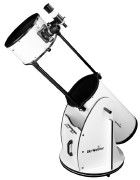Thinking about another telescope or two
Of course I’m not going to stop at just one telescope. The NexStar 5 SE I bought last fall is a fine scope, but it has its limitations. For one thing, 125 mm isn’t a lot of aperture. It’s also limited to a maximum 1.2-degree field of view (some astronomical targets are wider than that). And while it’s luggable at 12.5 kilograms, there are times when something even more portable — the vaunted “quick-look” category — would be more desirable. Especially when the NexStar’s electronics require additional setup time.
These desires — more portability and more aperture — can be addressed relatively inexpensively. (I said relatively. Let’s not talk about astrophotography rigs for the time being.)
One category of telescope I’m looking at is the small apochromatic refractor. A short-focal-length scope with an aperture of 66 mm or so, using low-dispersion glass to minimize chromatic aberration, can give wide-field views while weighing only a couple of pounds. Which means I can mount one on my camera tripod; it’d also make an inexpensive telephoto lens when connected to my Nikon. I’m leaning toward William Optics’s Zenithstar 66 SD, a 66mm f/5.9 scope that has received some pretty good reviews; it runs for about $400 with a diagonal and case. Its focuser is the same diameter as a Schmidt-Cassegrain’s, so there would be accessory compatibility. Sky-Watcher’s Equinox 66 is another option, but it’s slightly longer, heavier, and more expensive.
 As for more aperture, I’m also thinking about Dobsonians again; they were my first choice until I realized that the field from which we do our observing is too far away to haul a Dob of reasonable aperture. They’re just too heavy. But Sky-Watcher has a new line of Dobs coming out that might tip the scales, so to speak, back in their direction. Most Dobs are either solid metal tubes or use a truss design; the new FlexTube Dobs use a collapsible design that doesn’t come apart. Early reports (Cloudy Nights, Stargazers’ Lounge) suggest that these scopes stay in collimation much better than truss Dobs, which have to be collimated every time they’re put together. The FlexTubes are more portable in that they’re collapsible and therefore smaller; it will remain to be seen whether they’re also light enough to be luggable; I haven’t seen any weight information yet. Even a truss Dob can weigh a bit, unless you want to shell out for one of these. I’m looking longingly at the 12-inch FlexTube, which should cost less than $1,000 in Canada, and hoping it will be light enough for us to use. We’ll see when they’re in stock.
As for more aperture, I’m also thinking about Dobsonians again; they were my first choice until I realized that the field from which we do our observing is too far away to haul a Dob of reasonable aperture. They’re just too heavy. But Sky-Watcher has a new line of Dobs coming out that might tip the scales, so to speak, back in their direction. Most Dobs are either solid metal tubes or use a truss design; the new FlexTube Dobs use a collapsible design that doesn’t come apart. Early reports (Cloudy Nights, Stargazers’ Lounge) suggest that these scopes stay in collimation much better than truss Dobs, which have to be collimated every time they’re put together. The FlexTubes are more portable in that they’re collapsible and therefore smaller; it will remain to be seen whether they’re also light enough to be luggable; I haven’t seen any weight information yet. Even a truss Dob can weigh a bit, unless you want to shell out for one of these. I’m looking longingly at the 12-inch FlexTube, which should cost less than $1,000 in Canada, and hoping it will be light enough for us to use. We’ll see when they’re in stock.
Meanwhile, I expect to grab a small apo soon.
(Fortunately, telescopes last forever, and don’t require regular feeding.)